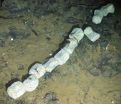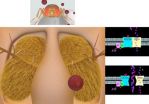(Press-News.org) Marine biologists have, for the first time, found a whale skeleton on the ocean floor near Antarctica, giving new insights into life in the sea depths. The discovery was made almost a mile below the surface in an undersea crater and includes the find of at least nine new species of deep-sea organisms thriving on the bones.
The research, involving the University of Southampton, Natural History Museum, British Antarctic Survey, National Oceanography Centre (NOC) and Oxford University, is published today in Deep-Sea Research II: Topical Studies in Oceanography.
"The planet's largest animals are also a part of the ecology of the very deep ocean, providing a rich habitat of food and shelter for deep sea animals for many years after their death," says Diva Amon, lead author of the paper based at University of Southampton Ocean and Earth Science (which is based at NOC) and the Natural History Museum. "Examining the remains of this southern Minke whale gives insight into how nutrients are recycled in the ocean, which may be a globally important process in our oceans."
Worldwide, only six natural whale skeletons have ever been found on the seafloor. Scientists have previously studied whale carcasses, known as a 'whale fall', by sinking bones and whole carcasses. Despite large populations of whales in the Antarctic, whale falls have not been studied in this region until now.
"At the moment, the only way to find a whale fall is to navigate right over one with an underwater vehicle," says co-author Dr Jon Copley of University of Southampton Ocean and Earth Science. Exploring an undersea crater near the South Sandwich Islands gave scientists just that chance encounter. "We were just finishing a dive with the UK's remotely operated vehicle, Isis, when we glimpsed a row of pale-coloured blocks in the distance, which turned out to be whale vertebrae on the seabed," continues Dr Copley.
When a whale dies and sinks to the ocean floor, scavengers quickly strip its flesh. Over time, other organisms then colonise the skeleton and gradually use up its remaining nutrients. Bacteria break down the fats stored in whale bones, for example, and in turn provide food for other marine life. Other animals commonly known as zombie worms can also digest whale bone.
"One of the great remaining mysteries of deep ocean biology is how these tiny invertebrates can spread between the isolated habitats these whale carcasses provide on the seafloor," says co-author Dr Adrian Glover at the Natural History Museum. 'Our discovery fills important gaps in this knowledge.'
The team surveyed the whale skeleton using high-definition cameras to examine the deep-sea animals living on the bones and collected samples to analyse ashore. Researchers think that the skeleton may have been on the seafloor for several decades. Samples also revealed several new species of deep-sea creatures thriving on the whale's remains, including a 'bone-eating zombie worm' known as Osedax burrowing into the bones and a new species of isopod crustacean, similar to woodlice, crawling over the skeleton. There were also limpets identical to those living at nearby deep-sea volcanic vents.
INFORMATION:
Notes for editors:
1. The full reference: Amon DJ, Glover AG, Wilkund H, Marsh L, Linse K, Rogers AD & Copley JT (2013) The discovery of a natural whale fall in the Antarctic deep sea. Deep-Sea Research II: Topical Studies in Oceanography, published online at
http://www.journals.elsevier.com/deep-sea-research-part-ii-topical-studies-in-oceanography
2. There are a number of images and videos of the new species and the whale skeleton available. To access these resources, please visit http://www.dropbox.com and "Sign in" (top right) as follows:
Email: antarcticwhalefall@yahoo.com
Password: caldera
Please note that you do not need to install Dropbox software or be invited to "share" the folder to access these resources, which can be downloaded directly via any web browser using the login details above. Please refer to the README.txt file in the folder for descriptions of photos, video shot list, and copyright / credit information for media use.
3. The whale skeleton was discovered during RRS James Cook Voyage 42 in January 2010, for which the Principal Scientist was Prof Alex Rogers of Oxford University. The expedition was part of the CheSsSo (Chemosynthetic Ecosystems of the Southern Ocean) research programme, funded by the UK Natural Environment Research Council and led by Prof Paul Tyler at University of Southampton Ocean and Earth Science.
4. Diva Amon is a PhD student at the Graduate School of the National Oceanography Centre Southampton (University of Southampton) and Natural History Museum, co-supervised by Dr Jon Copley at the University of Southampton and Dr Adrian Glover at the Natural History Museum.
5. Funding for the research is provided by the Graduate School of the National Oceanography Centre Southampton, University of Southampton and the Leslie M. and Judy A. Crouch Educational Trust.
6. The University of Southampton is a leading UK teaching and research institution with a global reputation for leading-edge research and scholarship across a wide range of subjects in engineering, science, social sciences, health and humanities. http://www.southampton.ac.uk
7. The Natural History Museum is an award-winning tourist attraction and also a world-leading science research centre. Through its collections and scientific expertise, the Museum works to help understand and maintain the richness and diversity of our planet, with groundbreaking partnerships in more than 70 countries. For more information please go to http://www.nhm.ac.uk
8. The National Oceanography Centre (NOC) is the UK's leading institution for integrated coastal and deep ocean research. NOC operates the Royal Research Ships James Cook and Discovery and develops technology for coastal and deep ocean research. Working with its partners NOC provides long-term marine science capability including: sustained ocean observing, mapping and surveying, data management and scientific advice.
NOC operates at two sites, Southampton and Liverpool, with the headquarters based in Southampton. http://www.noc.ac.uk
For further information please contact:
Catherine Beswick, Media and Communications Officer, National Oceanography Centre, Tel: 023 8059 8490, email: catherine.beswick@noc.ac.uk
Glenn Harris, Media Relations, University of Southampton, Tel: 023 8059 3212 email: G.Harris@soton.ac.uk
The Natural History Museum Press Office, Tel: 020 7942 5654, email: press@nhm.ac.uk
Antarctica's first whale skeleton found with 9 new deep-sea species
2013-03-18
ELSE PRESS RELEASES FROM THIS DATE:
Significant contribution of Greenland's peripheral glaciers to sea-level rise
2013-03-18
The scientists looked at glaciers which behave independently from the ice sheet, despite having some physical connection to it, and those which are not connected at all.
The discovery, just published in Geophysical Research Letters, is important as it will help scientists improve the predictions of the future contribution of Greenland's ice to sea-level rise.
Using lasers which measure the height of the ice from space, and a recently completed inventory of Greenland's glaciers and ice caps, scientists from the European-funded ice2sea programme, were able to determine ...
Male lions use ambush hunting strategy
2013-03-18
Washington, D.C.— It has long been believed that male lions are dependent on females when it comes to hunting. But new evidence suggests that male lions are, in fact, very successful hunters in their own right. A new report from a team including Carnegie's Scott Loarie and Greg Asner shows that male lions use dense savanna vegetation for ambush-style hunting in Africa. Their work is published in Animal Behavior.
Female lions have long been observed to rely on cooperative strategies to hunt their prey. While some studies demonstrated that male lions are as capable at hunting ...
Pneumonia patients nearly twice as likely to suffer from depression, impairments
2013-03-18
ANN ARBOR, Mich. — The long-term consequences of pneumonia can be more detrimental to a person's health than having a heart attack, according to joint research from the University of Michigan Health System and University of Washington School of Medicine.
Older adults who are hospitalized for pneumonia have a significantly higher risk of new problems that affect their ability to care for themselves, and the effects are comparable to those who survive a heart attack or stroke, according to the new findings in the American Journal of Medicine.
"Pneumonia is clearly not ...
Solar storm near Earth caused by fast CME
2013-03-18
VIDEO:
This NASA research model, prepared on Mar. 15, 2013, from a space weather model known as ENLIL named after the Sumerian storm god, shows the way the CME was expected...
Click here for more information.
On March 17, 2013, at 1:28 a.m. EDT, the coronal mass ejection (CME) from March 15 passed by NASA's Advanced Composition Explorer (ACE) as it approached Earth. Upon interacting with the giant magnetic bubble surrounding Earth, the magnetosphere, the CME caused a kind of ...
It's in the cards: Human evolution influences gamblers' decisions, study shows
2013-03-18
New research from an international team of scientists suggests evolution, or basic survival techniques adapted by early humans, influences the decisions gamblers make when placing bets.
The findings may help to explain why some treatment options for problem gamblers often don't work, the researchers say.
For the study, recently published in Frontiers in Psychology, scientists from McMaster University, the University of Lethbridge and Liverpool John Moores University examined how gamblers made decision after they won or lost.
They found that, like our ancestors, ...
Research find links between lifestyle and developing rheumatoid arthritis
2013-03-18
Researchers in Manchester have found a link between several lifestyle factors and pre-existing conditions, including smoking cigarettes and diabetes, and an increased risk of developing rheumatoid arthritis.
Rheumatoid Arthritis (RA) is a chronic disease which affects around 0.8% of the population; and its causes are of great interest to the medical world. Research led by Professor Ian Bruce, NIHR Senior Investigator and Professor of Rheumatology at The University of Manchester and consultant at Central Manchester University Hospitals NHS Foundation Trust, looked into ...
NASA sees leaping lunar dust
2013-03-18
Electrically charged lunar dust near shadowed craters can get lofted above the surface and jump over the shadowed region, bouncing back and forth between sunlit areas on opposite sides, according to new calculations by NASA scientists.
The research is being led by Michael Collier at NASA's Goddard Space Flight Center, Greenbelt, Md., as part of the Dynamic Response of the Environment At the Moon (DREAM) team in partnership with the NASA Lunar Science Institute (NLSI), managed at NASA's Ames Research Center, Moffett Field, Calif.
"The motion of an individual dust particle ...
Earth's interior cycles contributor to long-term sea-level & climate change, scientists conclude
2013-03-18
Ancient rises in sea levels and global warming are partially attributable to cyclical activity below the earth's surface, researchers from New York University and Ottawa's Carleton University have concluded in an analysis of geological studies.
However, the article's authors, NYU's Michael Rampino and Carleton University's Andreas Prokoph, note that changes spurred by the earth's interior are gradual, taking place in periods ranging from 60 million to 140 million years—far less rapidly than those brought on by human activity.
Their analysis appears in Eos, a newspaper ...
Transistor in the fly antenna
2013-03-18
This press release is available in German.
Highly developed antennae containing different types of olfactory receptors allow insects to use minute amounts of odors for orientation towards resources like food, oviposition sites or mates. Scientists at the Max Planck Institute for Chemical Ecology in Jena, Germany, have now used mutant flies and for the first time provided experimental proof that the extremely sensitive olfactory system of fruit flies − they are able to detect a few thousand odor molecules per milliliter of air, whereas humans need hundreds of millions ...
Tiny minotaurs and mini-Casanovas: Ancient pigmy moths reveal secrets of their diversity
2013-03-18
Researchers Robert Hoare (Landcare Research, New Zealand) and Erik van Nieukerken (Naturalis Biodiversity Center, Netherlands) have named new moths after the Minotaur of Greek mythology and the legendary Italian philanderer Giacomo Casanova in a study of the evolution of southern pigmy moths. The study was published in the open access journal ZooKeys.
The tiny moths, with wingspans of 3 to 8 millimetres, belong to a very old group (the family Nepticulidae), which dates back more than 110 million years to the time of the dinosaurs. Australian pigmy moths are particularly ...




